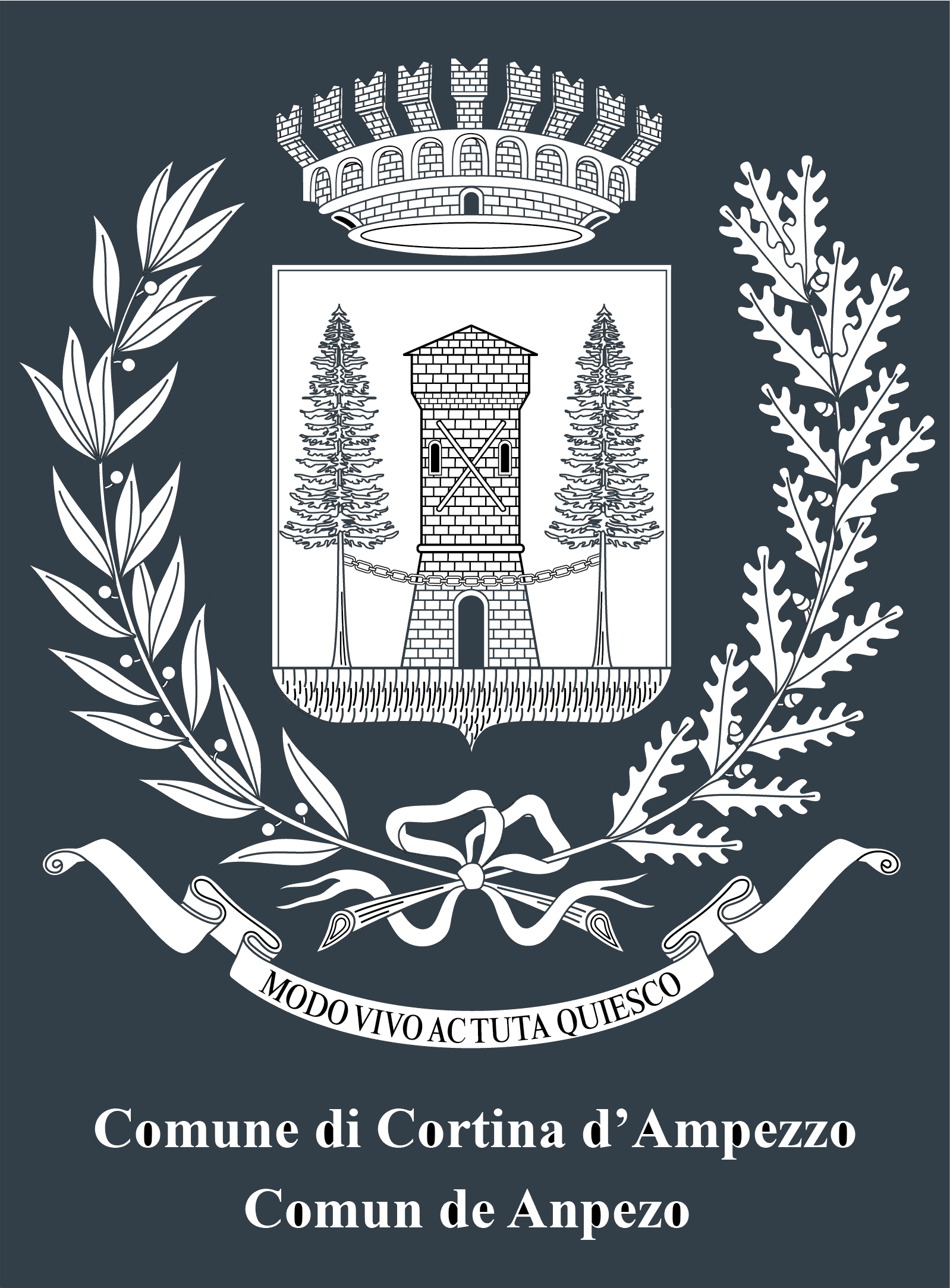Built between 1769 and 1775 based on a design by the architect M. Promperg-Costa, it houses artistic treasures of considerable value: the late Baroque High Altar by Johann Müssack with a painting by Antonio Zanchi; the altar of the Madonna del Carmine in carved, painted and gilded wood, attributed to Antonio Lazzarini from Belluno and the altar of the Madonna del Rosario, with the tabernacle, attributed to the Belluno school of Andrea Brustolon.
Also the frescoes by Franz Anton Zeiler and Giuseppe Ghedina, a versatile artist from Ampezzo who was active in the 19th century between Veneto and Friuli.
The patron saints of Cortina are celebrated on May 3, although there is a deep devotion to the Madonna della Difesa, celebrated by institutions and offices on 19 January.
The bell tower of Cortina was erected by Silvestro Franceschi to replace the old bell tower from 1590 which was now in danger of collapsing. Built in Dolomite extracted in the Crepedel area of Acquabona, it followed the idea of the Viennese engineer Hermann Bergmann, who designed a bell tower in neo-Gothic style, neither Tyrolean nor Cadore. In 1852, excavation of the foundations began and in 1858 the six bells, created in Innsbruck by the German company Grassmajer, rang for the first time.
A peculiarity is that today the same original bells from 1857 ring out, saved during the Great War, unlike many other Italian ones melted down to create cannons.
In the hamlet of Grava, it is the largest church among those of the Sestieri after the Basilica. Consisting of a single nave, it has a single altar dedicated to the Virgin. Particularly striking are the two painted wooden sculptures by Corrado Pitscheider, placed on the sides: on the right, St. Lucia holds a tray on which are the eyes torn out by the executioner; on the left, St. Michael the Archangel is depicted in the act of crushing a terrifying Demon in chains.
Owned by the Costantini family, the first written testimony mentioning it dates back to 1396. Inside you can admire an eighteenth-century wooden altar and, on the choir wall, an enchanting fresco from the late fourteenth century depicting three Saints: from the right, Saint Bartholomew, Saint Jude Thaddeus and Saint Matthias. Many scholars believe that the three figures were part of a larger fresco depicting the Twelve Apostles.
It was built to thank the Virgin Mary who, as it is said, did not hesitate to “take sides” to stop the imperial troops of Sigismund of Luxembourg at Cimabanche in 1412. From this episode – often overlapped with the legendary intervention of the Virgin Mary against the Goths many centuries before – was born the cult of Madonna della Difesa, celebrated in Cortina every 19th January, and indeed the Madonna della Difesa Church, of the second half of the fifteenth century.
In 1743 the church was rebuilt and was consecrated only eighteen years later: a place that is worth a visit, also for the paintings, icons and magnificent decorations kept inside.
The ceiling features The Armed Virgin, a lively eighteenth-century panel depicting the intervention of the Virgin, armed with a sword; on the high altar is the marvellous wooden statue from the late fifteenth century dedicated to the Virgin Mary.
Completed in 1713, it has a single nave and is clearly in eighteenth-century style. The wooden altar with columns decorated with vine leaves and bunches of grapes dates back to the 17th century, one of the last existing in Cortina. Inside there is an altarpiece depicting St. Giuliana, St. Antonio da Padova and the Virgin with Child surrounded by angels and cherubs. St. Giuliana is also depicted in a beautiful canvas from the Venetian school, dated 1692 and placed on the right side wall, which presents the saint as a rich aristocrat, adorned with a diadem and glittering earrings.
This small chapel, also called Causa nostrae Letitiae, was built in 1931 by the engineer Ermete Alessandrini of Milan in the park of his villa (now demolished), located on the slopes of Faloria.
The chapel was originally privately owned, but in 1939 it was sold to the parish of Cortina.
What makes it exciting is its position in a meadow where a row of trees provide shade to the little road that gently climbs from the houses of Cojana towards the chapel.
Inside there is a bas-relief of the Madonna and Child in neo-Renaissance style.
Built in the first half of the eighteenth century as a vow by the Ampezzo village of Campo di Sopra against the fires that had destroyed it several times, during the First World War it was damaged again by a disastrous fire that hit a large part of the village: it was rebuilt and reopened for worship in 1928.
It is curious to note that in the Campo chapel there is no image of St. Candido, while there are four images of St. Florian, depicted as a Roman soldier and who, having suffered martyrdom by drowning, is venerated as the protector of fires and floods.
Inside there are three different altars with the figures of St. Florian and the Holy Family, St. John the Baptist, St. Florian and the Saints.
On the left wall there is one of the artistic jewels of Cortina and of wooden sculpture from the early sixteenth century: the Flügelaltar of St. Catherine, coming from the church of the same name in Cortina, which no longer exists today.
Consecrated in 1604, it underwent expansion works which were completed in 1850.
The external decoration and much of the internal decoration are by the Peskoller brothers, members of a family of artists from Val Badia.
The church is enriched by three wooden altars: the main one, with the altarpiece of the “Deposition” by Giovanni Maria Ghedini; the one on the right by “Mistro Marchio Mayer” who also painted the altarpiece of the Souls in Purgatory placed on the counter-façade but which was originally part of this altar. In its place now stands the canvas of the Madonna and Child between Saints Rocco and Sebastian, commissioned by the community of Zuel at the time of the plague epidemic of the 17th century. The third altar houses the “Cristo de Zuel”, a crucifix found in the summer of 1695 among the straw of a stable in Zuel.
Built in Col in 1671 but rebuilt in 1839, it has a wooden altar with a canvas depicting St. Andrew between the Saints Silvestri I Pope and Anthony of Padua gathered in the presence of the Madonna and Child.
On the ceiling is a fresco depicting the martyrdom of Saint Andrew, created by native Ampezzo Dino Degasper in 1934.
Built in the eighteenth century and dedicated to the Blessed Virgin of Health, it recalls a miracle that occurred in this area of a paralytic child healed by the apparition of the Madonna.
On the façade, a lunette by Giuseppe Ghedina depicting the Souls in Purgatory and the Madonna and Child. Inside there are two paintings depicting Saint Francis and the Madonna of Trens and two frescoes by Alvise Zorzi from Venice.
Completed in 1791, it was soon rebuilt from the ashes of a fire that had destroyed it along with the entire village of Chiave.
The main altar, dating back to the 17th century, houses the altarpiece of St. Anthony by Giuseppe Lacedelli from Cortina and a very sweet canvas of the Virgin Mary with her Child. On the counter-façade there is an eighteenth-century canvas of St. John writing the Gospel. In the nave there is a valuable wooden altar with statues of the Virgin Mary, St. Francis, St. John the Baptist and other Saints.
The history of the elegant chapel of Majon is linked to that of the de Zanna family: in fact, it stands close to one of the perimeter towers of the castle that Giovanni Maria de Zanna attempted to build starting in 1700. We recall in fact that in 1692 this Cortina leader had been awarded the title of “Noble of the Holy Trinity and Royal Stone”: this is where the dedication of the family chapel comes from.
Noteworthy inside is a devotional altarpiece depicting the Virgin Mary and Child between Saints Domenica and Antonio da Padova, the de Zanna couple in eighteenth-century clothing with their children, some depicted as living and others as deceased.
In 1958, the Andreis couple from Trento, who managed the hotel at Passo Falzarego, promoted the construction of a simple white church with a gabled roof.
The interior is enriched by the fresco of the Visitation of Mary to Elizabeth by Vittorio Casetti.
To the right of the Pocol Military Shrine square stands the charming little church built in 1916 by the Alpine troops of the fifth Group as a chapel for the war cemetery that once existed in the same place and was called “Alle Aquile delle Tofane”.
The entrance steps, carved into the rock, are flanked by the bronze tablets of the Via Crucis by Giannino Castiglioni.
Inaugurated on 3 September 2000, in the year of the great Jubilee, it is a characteristic wooden structure with a wonderful location along the Passo Falzarego, situated in the mountain environment.
It was built on the initiative of the National Alpine Association (ANA) – Cortina d’Ampezzo Group, to dedicate it to all the European soldiers who fell during the last wars.
The patron saint of the little church is the Madonna delle Tofane: a statue of the Virgin Mary reminds us that the pain that the Madonna lavished at the foot of the cross on the tortured body of her son extends to all those who have fallen under the violence of history.
Built in 1226 on the northern border of the Ampezzo territory where since the 11th century there had been a lodging for travellers, pilgrims and those who travelled this important road transporting goods from Venice to Germany and vice versa. It is not without significance that the little church was dedicated to Saint Nicholas, venerated in the Alpine area as the protector of travellers.
Following the Josephine reforms of 1781 and World War I, the church was stripped and looted, resulting in the disappearance of many of its furnishings.
On the plastered walls of the nave, numerous ochre brush inscriptions can be read, containing acrostics, monograms, double crosses and late sixteenth-century datings. Three incomplete but still legible panels depict a cycle of frescoes by a local painter. On the sails are the coats of arms of the Regola Alta of Lareto and of the Captain of the castle of Botestagno who in 1572 was responsible for the expansion of the church. On the only remaining altar there is today an altarpiece from the German school of the 16th century.




Head Office: Loc. Sacus 4, 32043 Cortina d’Ampezzo (BL) – P.I. 00806650255 | Privacy Policy – Cookie Policy
A partire da giovedì 4 dicembre, ogni famiglia residente a Cortina potrà ritirare gratuitamente la bandiera con il nuovo emblema presso lo IAT di Piazza Roma.
Vivi la storia — sogna Milano‑Cortina.